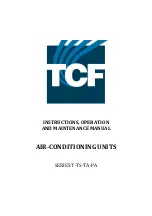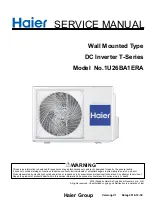
10 Indoor Unit Installation
Step 4: Prepare refrigerant piping
The refrigerant piping is inside an insulating sleeve attached to the back
of the unit. You must prepare the piping before passing it through the
hole in the wall. Refer to the Refrigerant Piping Connection section of this
manual for detailed instructions on pipe flaring and flare torque
requirements, technique, etc.
1
Based on the position of the wall hole relative to the mounting plate,
choose the side from which the piping will exit the unit.
2
If the wall hole is behind the unit, keep the knock-out panel in place.
If the wall hole is to the side of the indoor unit, remove the plastic
knock-out panel from that side of the unit. (See Fig. 4.4). This will
create a slot through which your piping can exit the unit. Use needle
nose pliers if the plastic panel is too difficult to remove by hand.
Figure
4-4
3
Use scissors to cut down the length of the insulating sleeve to reveal
about 15cm (6in) of the refrigerant piping. This serves two
purposes:
•
To facilitate the Refrigerant Piping Connection process
•
To facilitate Gas Leak Checks and enable you to check for dents
4
If existing connective piping is already embedded in the wall,
proceed directly to the Connect Drain Hose step. If there is no
embedded piping, connect the indoor unit's refrigerant piping to the
connective piping that will join the indoor and outdoor units. Refer
to the Refrigerant Piping Connection section of this manual for
detailed instructions.
5
Based on the position of the wall hole relative to the mounting plate,
determine the necessary angle of your piping.
6
Grip the refrigerant piping at the base of the bend.
7
Slowly, with even pressure, bend the piping towards the hole.
Do not dent or damage the piping during the process.
NOTE ON PIPING ANGLE
Refrigerant piping can exit the indoor unit from four different angles:
•
Left-hand side
•
Left rear
•
Right-hand side
•
Right rear
Refer to Fig. 4.5 for details.
Figure
4-5
CAUTION
Be extremely careful not to dent or damage the piping while bending
them away from the unit. Any dents in the piping will affect the unit's
performance.
Step 5: Connect drain hose
By default, the drain hose is attached to the left-hand side of unit (when
you're facing the back of the unit). However, it can also be attached to the
right-hand side.
1
To ensure proper drainage, attach the drain hose on the same side
that your refrigerant piping exits the unit.
2
Attach drain hose extension (purchased separately) to the end of
drain hose.
3
Wrap the connection point firmly with /PTFE tape to ensure a good
seal and to prevent leaks.
4
For the portion of the drain hose that will remain indoors, wrap it
with foam pipe insulation to prevent condensation.
5
Remove the air filter and pour a small amount of water into the drain
pan to make sure that water flows from the unit smoothly.
NOTE ON DRAIN HOSE PLACEMENT
Make sure to arrange the drain hose according to Fig. 4.6.
DO NOT kink the drain hose.
DO NOT create a water trap.
DO NOT put the end of drain hose in water or a container that will
collect water.
Knock-out Panel
Bosch Climate 5000
6 720 866 139 (2016/07)











































